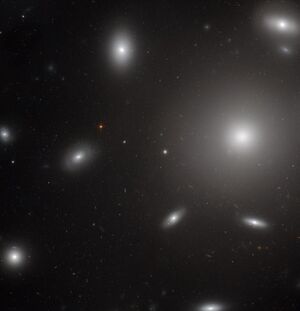Astronomy:NGC 4874
From HandWiki
Short description: Galaxy in the constellation Coma Berenices
| NGC 4874 | |
|---|---|
 NGC 4874 dominates this picture created from optical and near-infrared exposures taken with the Wide Field Channel of Hubble's Advanced Camera for Surveys. (Credit: ESA/Hubble, NASA) | |
| Observation data (J2000 epoch) | |
| Constellation | Coma Berenices |
| Right ascension | 12h 59m 35.709s[1] |
| Declination | +27° 57′ 33.80″[1] |
| Redshift | 0.023907±0.000007[2] |
| Distance (comoving) | 114.3 ± 8.0 Mpc (372.8 ± 26.09 Mly)h−10.6774[2] |
| Apparent magnitude (V) | 11.4[3] |
| Apparent magnitude (B) | 13.7[4] |
| Characteristics | |
| Type | cD; Di |
| Size | 79.792 to 82.79 kpc (260,250 to 270,020 ly) (diameter; D25.0 B-band and 2MASS K-band total isophotes[2] |
| Apparent size (V) | 1.9′ × 1.9′[2] |
| Other designations | |
| NGC 4874, NFP J125935.7+275734, [BGH2001] 237, [KK90] 169, B2 1257+28, 10P 236, [BO85] Coma 1, [L84] A1656-G2, 5C 4.85, SDSS J125935.70+275733.3, [BTM97] ACO 1656 2, [LGF2005] B125711+281340, CAIRNS J125935.60+275734.0, TT 12, [CHM2007] LDC 926 J125935.70+2757338, [LO95] 1257+282, FOCA 0728-499, UGC 8103, [CHM2007] HDC 745 J125935.70+2757338, [MHR2010] 194.8988+27.9593, GIN 765, UZC J125935.6+275734, [D80] ACO 1656 129, [MO2001b] J125935.7+275732.3, GMP 3329, 4W 1257+28W01, [DFO95] 246, [MOL2003] A1656 J125935+275730, GP 489, 7W 1257+28W01, [DLB87] C11, [OLK95] 1257+282, LEDA 44628, WSTB 74W16, [EDG2007] 3, [OR76] 1257+282, 2MASX J12593562+2757360, Z 1257.2+2814, [FBH2004] X281, [OSR2002] b089, 2MASX J12593570+2757338, Z 160-A22, [FBH2004] S89, [PL95] ACO 1656 G2, MCG+05-31-070, Z 160A-22, [FWB89] Galaxy 321, [ZBO89] ACO 1656-5, MPMM 123, Z 160-231, [K94] 125710.70+281346.0 | |
NGC 4874 is a supergiant elliptical galaxy. It was discovered by the United Kingdom astronomer Frederick William Herschel I in 1785, who catalogued it as a bright patch of nebulous feature. The second-brightest galaxy within the northern Coma Cluster, it is located at a distance of 109 megaparsecs (350,000,000 light-years) from Earth.
Characteristics
The galaxy is surrounded by an immense stellar halo that extends up to one million light-years in diameter. It is also enveloped by a huge cloud of interstellar medium that is currently being heated by action of infalling material from its central supermassive black hole. A jet of highly energetic plasma extends out to 1,700 light-years from its center. The galaxy has 18,700 ± 2,260 globular clusters.
See also
References
- ↑ 1.0 1.1 "SIMBAD basic query result". SIMBAD Astronomical Database. http://simbad.u-strasbg.fr/simbad/sim-basic?Ident=NGC+4874&submit=SIMBAD+search.
- ↑ 2.0 2.1 2.2 2.3 "NASA/IPAC Extragalactic Database". Results for NGC 4889. http://ned.ipac.caltech.edu/cgi-bin/objsearch?objname=NGC+4889&extend=no&hconst=67.80&omegam=0.268&omegav=0.683&corr_z=1&out_csys=Equatorial&out_equinox=J2000.0&obj_sort=RA+or+Longitude&of=pre_text&zv_breaker=30000.0&list_limit=5&img_stamp=YES.
- ↑ Michard, R.; Andreon, S. (2008). "Morphology of galaxies in the Coma cluster region down to M_B = -14.25. I. A catalog of 473 members". Astronomy and Astrophysics 490 (3): 923. doi:10.1051/0004-6361:200810283. Bibcode: 2008A&A...490..923M.
- ↑ Falco, Emilio E.; Kurtz, Michael J.; Geller, Margaret J.; Huchra, John P.; Peters, James; Berlind, Perry; Mink, Douglas J.; Tokarz, Susan P. et al. (1999). "The Updated Zwicky Catalog (UZC)". Publications of the Astronomical Society of the Pacific 111 (758): 438. doi:10.1086/316343. Bibcode: 1999PASP..111..438F.
External links
- "Galaxies in a Swarm of Star Clusters". Picture of the Week. ESA/Hubble. http://www.spacetelescope.org/images/potw1138a/.
 |

